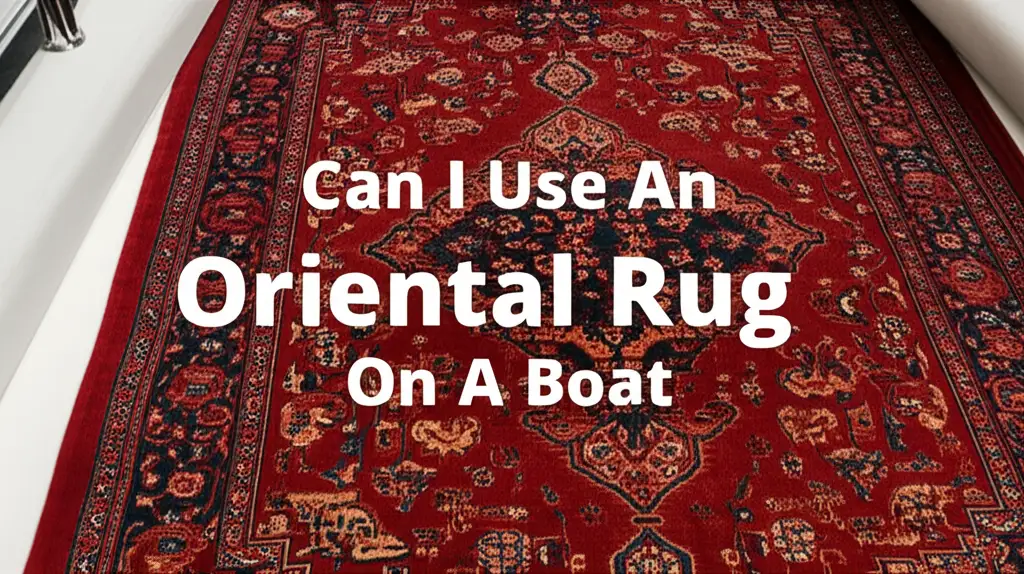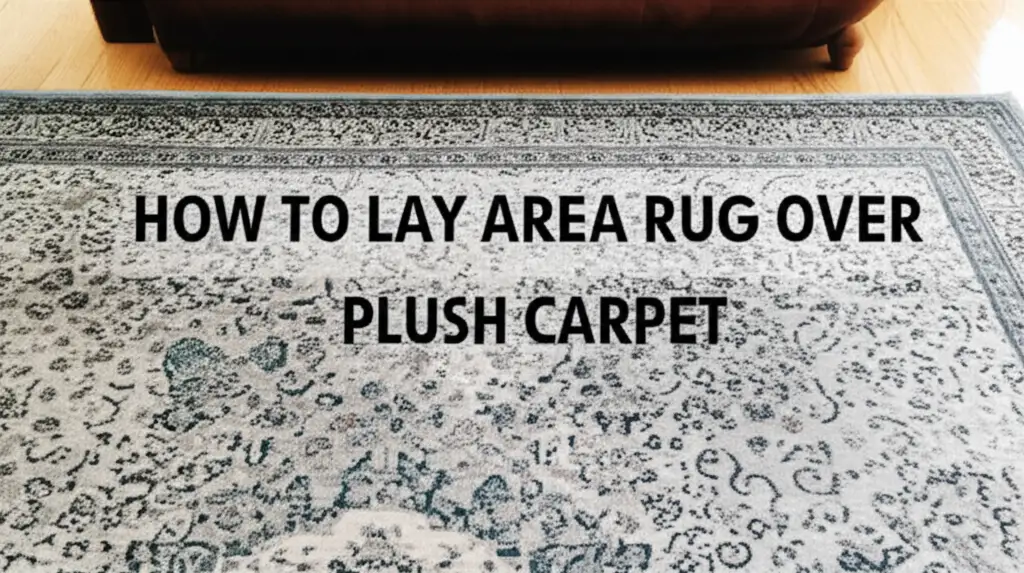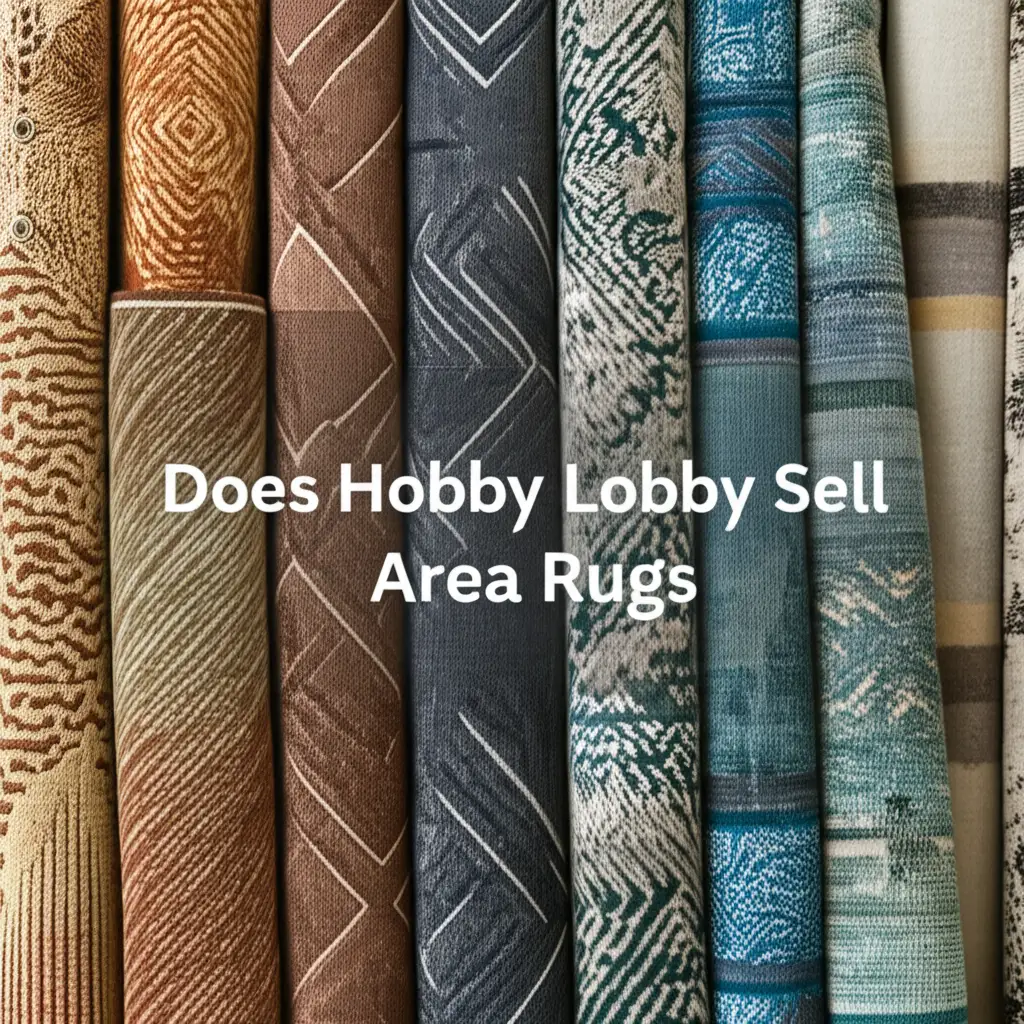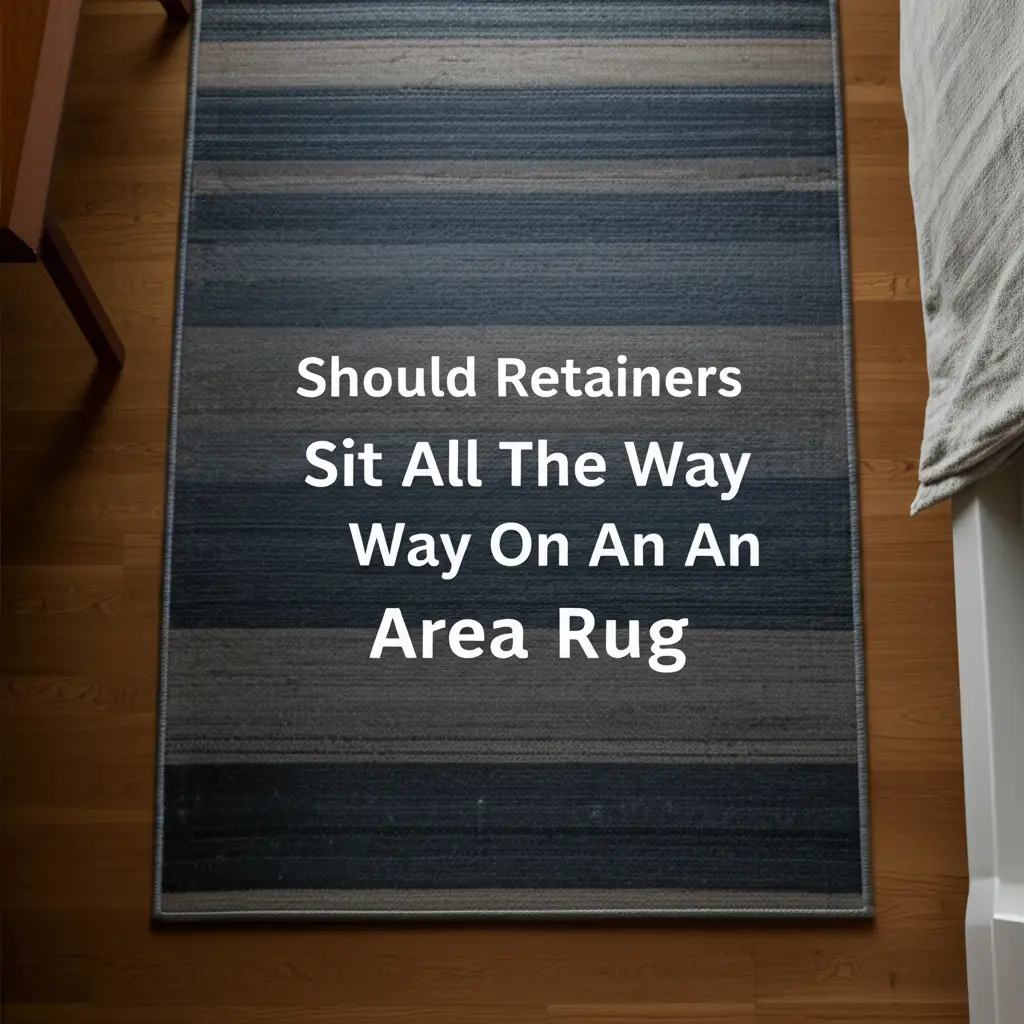· Liora Benning · Home Decor · 18 min read
Can I Use An Oriental Rug On A Boat

Oriental Rug on a Boat: A Practical Guide
Imagine the gentle sway of the water, the fresh sea air, and the comfort of your boat’s cabin. You might picture a space that feels just like home, complete with beautiful furnishings. For many, this dream includes the warmth and rich patterns of an Oriental rug. Using an Oriental rug on a boat adds an undeniable touch of luxury and personality.
But is it truly a good idea? The unique environment of a boat presents specific challenges for textiles. Moisture, sunlight, and constant movement can affect even the most durable rug. This article will explore the joys and potential pitfalls of using an Oriental rug on a boat. We will cover how to choose the right rug, essential care tips, and ways to protect your investment. Let’s make your boat cabin both stylish and functional.
Takeaway
- You can use an Oriental rug on a boat, but it requires careful selection.
- Traditional Oriental rugs are sensitive to moisture and sun.
- Proper care, including quick drying and UV protection, is essential.
- Choose smaller, durable rugs, preferably flat-weave.
- Consider marine-grade or synthetic alternatives for heavy use areas.
Can I Use An Oriental Rug On A Boat?
Yes, you can use an Oriental rug on a boat, but it comes with specific considerations. It adds beauty and comfort. You must choose the right type and commit to diligent care. This helps protect the rug from moisture, sun damage, and wear in a marine setting.
The Allure of an Oriental Rug on a Boat
Adding an Oriental rug to your boat’s interior can truly transform the space. These rugs bring a sense of history, artistry, and warmth. They turn a functional boat cabin into a cozy, inviting living area. Think about stepping onto a soft, intricately woven surface after a day on the water. It feels like stepping into a peaceful oasis.
An Oriental rug instantly upgrades the aesthetic. Its rich colors and complex patterns contrast nicely with typical boat materials like wood, fiberglass, or metal. This creates a luxurious and personalized atmosphere. Many boat owners want to extend their home’s comfort to their vessel. An Oriental rug helps achieve this feeling of familiarity and elegance. You can express your personal style on the water. This adds a touch of traditional charm to your adventurous lifestyle.
These rugs also offer practical benefits. They provide insulation against cold floors and absorb sound. This makes the cabin quieter and more comfortable. A rug can define a seating area or add a splash of color to a plain space. They feel soft underfoot. This comfort makes long trips more enjoyable. The beauty and comfort of an Oriental rug can turn a simple boat cabin into a true floating sanctuary.
Major Challenges for Rugs in a Marine Environment
Boats present a unique set of challenges for any textile, especially for delicate Oriental rugs. The marine environment is tough on materials. Understanding these issues helps you make smart choices. You can prepare for the care your rug will need.
First, moisture is a constant threat. Boats are humid places. Spills, splashes from the deck, or even condensation can make a rug damp. If a rug stays wet, it becomes a breeding ground for mold and mildew. Mold damages rug fibers, causes unpleasant smells, and can be a health hazard. Unlike a rug in a house, a boat rug might not dry easily. Air circulation is often limited below deck. This traps moisture and makes mold growth more likely. This is a critical factor for any rug on a boat.
Second, sunlight poses a significant danger. UV rays from the sun cause colors to fade over time. Traditional Oriental rugs often use natural dyes. These dyes are very susceptible to sun damage. Prolonged exposure can make vibrant patterns look dull and washed out. The sun also weakens rug fibers. This leads to faster wear and tear. A rug exposed to direct sunlight will not last as long as one kept in a shaded area. Protecting your rug from harsh UV rays is vital for its longevity.
Third, salt water adds another layer of difficulty. If salt water gets on your rug, it can leave behind corrosive salt crystals when it dries. These crystals can damage rug fibers over time. They also attract more moisture, which further encourages mold. Cleaning salt water from a rug requires specific methods to ensure all residues are gone. Normal cleaning might not remove all salt. This can lead to ongoing damage. The unique conditions of a boat, including the presence of salt, demand extra care for your rug. Consider how boat decks generally handle water; you would not typically power wash boat carpet if it were a delicate Oriental rug, highlighting the care difference.
Finally, the movement and limited space on a boat mean increased wear and tear. Foot traffic on a boat can be heavy in certain areas. Constant shifting and rubbing against boat surfaces can fray edges or thin out the pile. Rugs can slip on smooth boat decks, creating a safety hazard. This constant friction wears down the fibers faster than in a stable home environment. You might even consider if you can put carpeting on a steel boat deck for comparison, as permanent solutions differ greatly from movable rugs. These challenges show why choosing and caring for a boat rug needs extra thought.
Selecting the Right Oriental Rug for Boat Use
Choosing the perfect Oriental rug for your boat means balancing beauty with practicality. Not all rugs are equally suited for the marine environment. Your choice of material, weave, and size will impact the rug’s durability and ease of care. Make smart choices to enjoy your rug longer.
First, consider the material. Most Oriental rugs are made from wool, silk, or cotton. Wool is the most common and often the most durable. It naturally resists dirt and stains to some extent. However, wool absorbs moisture. If it gets wet, it can take a long time to dry. This makes it prone to mold and mildew in humid boat conditions. Silk rugs are incredibly beautiful but very delicate. They are not a good choice for high-traffic areas or damp environments. Silk is easily damaged by water and sunlight. Cotton rugs are lighter and dry faster than wool. They are also less durable and can show wear more quickly. For a boat, a wool rug is often the best traditional choice, despite its moisture absorption. You need to manage its exposure to water carefully.
Next, think about the rug’s weave. Flat-weave rugs, like Kilims or Dhurries, are generally better for boats than pile rugs. Flat-weaves do not have a thick pile. This means they dry much faster if they get wet. They are also lighter and easier to move around. Pile rugs, with their thick, soft surface, trap more moisture. This makes them more susceptible to mold. They also take longer to dry completely. A flat-weave rug can provide the aesthetic of an Oriental rug with less maintenance hassle in a boat setting. Their thinner profile also makes them less of a tripping hazard in compact boat spaces.
Finally, size and placement are very important. Smaller rugs are easier to manage on a boat. They are lighter to move for cleaning or drying. A large rug might be hard to get through a cabin door or lift when wet. Consider placing smaller rugs in specific zones, such as next to a bed or in front of a seating area. Avoid placing rugs directly in high-splash zones or areas exposed to constant direct sunlight. You might want to choose darker colors or patterns that hide dirt better. Lighter colors can show stains quickly, which is a common occurrence on a boat. A small, durable flat-weave wool rug is often your best bet for a blend of style and practicality.
Essential Care and Maintenance for Boat Rugs
Proper care is the key to keeping your Oriental rug looking good on a boat. The unique marine environment demands a consistent maintenance routine. Ignoring these steps can lead to permanent damage. Let’s make sure your rug stays beautiful for years.
Immediate attention to spills is vital. Accidents happen on boats, from spilled drinks to tracked-in water. If something spills on your Oriental rug, act fast. Blot the liquid immediately with a clean, dry cloth. Do not rub the spill, as this can spread it and push it deeper into the fibers. For solid spills, gently scrape them up before blotting. Speed prevents stains from setting. It also reduces the amount of moisture absorbed. This quick action is the first line of defense against damage.
Regular cleaning is also necessary. Vacuum your rug often, perhaps once a week or after every trip. Use a vacuum with strong suction but no beater bar, as beater bars can damage rug fibers. Regular vacuuming removes dirt, sand, and other debris that can abrade the fibers. It also helps prevent dust and grime from building up. Build-up can become harder to remove later. This simple step keeps your rug cleaner and extends its life.
Drying your rug is the most critical step for mold prevention. If your rug gets wet, even slightly, you must dry it completely and quickly. Take the rug out into the fresh air and sunlight (briefly, to avoid fading) if possible. Hang it over a rail or chairs so air can circulate on both sides. If you cannot take it outside, use fans or a dehumidifier in the cabin. Ensure the rug is bone dry before putting it back down or storing it. Moisture trapped in fibers leads to mold and mildew. This is a common problem for any textile on a boat. You can learn general tips about how to clean a rug by hand for small spots, or for more thorough cleaning, how do you clean an area wool rug which applies directly to most Oriental rugs.
For deeper cleaning, professional help is often best. Oriental rugs require specialized cleaning methods. They are too delicate for harsh chemicals or machine washing. A professional rug cleaner understands the specific needs of different fibers and dyes. They can remove deep-seated dirt and odors without damaging the rug. Never attempt to shampoo an area rug that is an Oriental rug unless specifically advised by a professional, as it can cause extensive damage or shrinkage. If your rug is made of wool, avoid using a dry machine for a wool carpet, as high heat will cause shrinking and damage. Proper, professional cleaning every few years helps maintain the rug’s beauty and extends its lifespan on your boat.
Protecting Your Oriental Rug on Board
Beyond regular cleaning, proactive protection is essential for your Oriental rug on a boat. The marine environment poses specific threats that require special attention. By taking these protective measures, you can significantly extend the life and beauty of your cherished rug.
First, invest in a good quality non-slip rug pad. This is not just for protecting the rug; it’s also for safety. Boats move, and a rug without a pad can slide, creating a serious tripping hazard. A non-slip pad will keep your rug securely in place. Look for pads made of breathable materials, like felt or natural rubber, that allow air circulation. Avoid solid rubber pads that can trap moisture underneath. A breathable pad helps prevent mold growth on both the rug and the boat floor. It also adds a layer of cushioning, which makes the rug feel softer underfoot. This simple addition is a must-have for any rug on a boat.
Second, protect your rug from harmful UV rays. Direct sunlight causes fading and fiber degradation over time. Position your rug away from areas of constant, direct sunlight, such as under large windows or open hatches. You can also install UV-filtering films on your boat windows. These films block a significant amount of harmful UV radiation without darkening the cabin. Consider using blinds or curtains during peak sun hours. This small effort can make a big difference in preserving your rug’s vibrant colors and structural integrity.
Third, ensure proper storage when the rug is not in use. If you leave your boat for extended periods, or during the off-season, remove the rug. Roll it up tightly, never fold it, to prevent creases and damage to the fibers. Store it in a dry, cool, and well-ventilated area. Avoid storing it in a damp locker or a sealed plastic bag. Plastic bags can trap moisture and encourage mold growth. Use a breathable fabric bag for storage. This protects the rug from dust and insects while allowing it to breathe.
Finally, maintain good air circulation and humidity control within your boat cabin. Use a dehumidifier to keep moisture levels low, especially in closed-up spaces. Open hatches and windows when possible to allow fresh air to circulate. Good ventilation helps to dry out any lingering moisture in the air and on surfaces, including your rug. These combined efforts create an environment where your Oriental rug can thrive. They keep it beautiful despite the challenges of boat life.
When a Traditional Rug Isn’t the Best Choice: Alternatives
While the allure of an Oriental rug on a boat is strong, it is important to admit that it might not always be the most practical choice. For some areas or certain boat types, traditional rugs may simply not hold up. Thankfully, many excellent alternatives exist. These options offer durability and style, often with less maintenance.
One of the most popular alternatives is outdoor or marine-grade rugs. These rugs are specifically designed to withstand harsh weather conditions, including sun, rain, and salt water. They are usually made from synthetic fibers like polypropylene, nylon, or polyester. These materials are naturally resistant to mold, mildew, and fading. They dry quickly and are easy to clean. You can often hose them down. Marine-grade rugs come in a wide range of colors and patterns. Some even mimic the look of natural fibers or traditional designs. They provide comfort and style without the worry of damage that comes with a delicate Oriental rug. This makes them ideal for boat decks, cockpits, or cabins with heavy foot traffic.
Another practical alternative is custom boat carpeting. This type of carpet is made specifically for marine use. It is often glued down or snapped into place, providing a secure, non-slip surface. Boat carpeting is usually low-pile or loop-pile. This makes it durable and easy to clean. It resists water and UV damage better than household carpets. Custom options allow you to choose colors and textures that match your boat’s interior. This creates a seamless and integrated look. While it lacks the intricate patterns of an Oriental rug, it offers superior performance and safety for a boat.
Other useful options include rubber mats or vinyl flooring. Rubber mats are excellent for high-traffic or wet areas, like entryways or galley floors. They offer superb slip resistance and are very easy to clean. Vinyl flooring is another durable and waterproof choice. Modern vinyl comes in styles that imitate wood, tile, or stone. It provides a clean, contemporary look with minimal maintenance. These options prioritize function and longevity in the demanding boat environment. While they do not offer the soft, luxurious feel of an Oriental rug, they provide reliable performance. They reduce the constant worry of damage and deterioration.
The choice depends on your boat’s specific use and your personal priorities. If you sail in rough conditions or host many guests, a marine-grade alternative might be wiser. If your boat is a calm, pampered oasis, a carefully selected Oriental rug could work well in a protected area. You can even combine them. Use an Oriental rug in a very protected cabin area and marine-grade options elsewhere. This balances beauty with practicality.
Installation and Placement Tips for Boat Rugs
Once you choose an Oriental rug for your boat, how you install and place it makes a big difference. Proper placement protects the rug and enhances the safety and comfort of your cabin. These tips will help you integrate your rug beautifully and practically.
First, choose the right location. Not all areas of a boat are suitable for an Oriental rug. Avoid placing them in high-splash zones or areas directly exposed to rain. This includes cockpits, open decks, or near the companionway leading outside. These areas are prone to excessive moisture. The cabin’s main living space, like a salon or sleeping berth, is often a better choice. These spaces offer more protection from the elements. Consider placing the rug under a table or in a cozy corner. This limits direct foot traffic and reduces wear. You want the rug to enhance comfort without becoming a maintenance burden.
Second, always use a high-quality non-slip rug pad. This is critical for safety on a moving boat. A rug pad keeps the rug from sliding around. It protects people from falls. Choose a pad that is slightly smaller than the rug itself. This prevents the pad edges from showing. A good pad also provides a breathable layer between the rug and the boat floor. This airflow is important for preventing moisture buildup. It helps to deter mold and mildew growth. Ensure the pad is made of materials that will not degrade or stick to your boat’s flooring over time.
Third, consider how the rug interacts with existing boat features. Make sure the rug does not obstruct doors, hatches, or storage compartments. It should not interfere with any moving parts or safety equipment. Lay out the rug and test all access points before securing it. If the rug is too large, it might bunch up. This creates tripping hazards and looks messy. Sometimes, it is better to use multiple smaller rugs than one large one. Smaller rugs are easier to move for cleaning or during rough weather. They offer more flexibility in arrangement.
Finally, think about securing the rug in place. Even with a non-slip pad, a boat’s constant motion might cause some shifting. For extra security, you can use rug grippers or double-sided rug tape designed for marine use. However, be cautious with tape, as some types can damage delicate rug fibers or boat surfaces. Test a small, hidden area first. For permanent placement, you might even consider adding a thin border around the rug with a low-profile trim. This holds it down without being invasive. These installation steps help your Oriental rug become a stable and beautiful addition to your boat’s interior.
FAQ Section
Q1: Can any Oriental rug go on a boat? No, not all Oriental rugs are suitable. Delicate silk rugs are too fragile for a boat’s environment. Wool rugs are generally more durable. Flat-weave rugs like Kilims are often better than thick pile rugs. This is because they dry faster and resist moisture damage more effectively. Always consider the rug’s material and weave.
Q2: How do I prevent mold on a boat rug? To prevent mold, ensure your rug dries completely and quickly after any moisture exposure. Use fans or a dehumidifier in the cabin to reduce humidity. Take the rug off the boat to dry in the sun (briefly) or fresh air when possible. Do not put a damp rug back down or store it.
Q3: What’s the best way to clean a rug on a boat? For minor spills, blot immediately with a clean cloth. For regular cleaning, vacuum the rug gently without a beater bar. For deeper cleaning, it’s best to have Oriental rugs professionally cleaned. Avoid harsh chemicals or machine washing, as these can damage the delicate fibers.
Q4: Do I need a rug pad on a boat? Yes, a non-slip rug pad is essential on a boat. It keeps the rug from sliding, which prevents accidents and injuries. A breathable pad also allows air circulation underneath the rug. This helps prevent moisture buildup and mold growth, protecting both the rug and your boat’s flooring.
Q5: How do I protect a rug from sun damage on a boat? Protect your rug from sun damage by positioning it out of direct sunlight when possible. Use UV-filtering window films on boat windows. You can also deploy blinds or curtains during peak sun hours. This reduces fading and fiber weakening caused by strong UV rays.
Q6: Are synthetic rugs better for boats than wool? For most boat applications, synthetic rugs (like marine-grade polypropylene) are generally more practical than traditional wool. Synthetics resist moisture, mold, and fading better than wool. They are also easier to clean and dry quickly. Wool rugs offer more luxury but need much more careful maintenance in a marine environment.
Conclusion
Bringing an Oriental rug onto your boat offers a unique blend of luxury and personal style. It transforms a functional space into a cozy, elegant retreat. You can indeed use an Oriental rug on a boat. However, this choice demands careful thought and commitment. You must select the right type of rug, prioritize protection, and commit to consistent maintenance.
Remember to choose durable wool or flat-weave rugs. Always use a non-slip, breathable rug pad for safety and air circulation. Be diligent in protecting your rug from moisture and direct sunlight. Promptly dry any wet spots and consider professional cleaning for deeper care. If the marine environment is too harsh for a traditional rug, excellent synthetic alternatives offer similar comfort with greater durability.
Ultimately, the decision rests on your boat’s use and your willingness to maintain the rug. With smart choices and proper care, your Oriental rug can be a cherished addition to your boat’s interior. Enjoy the comfort and beauty it brings to your adventures on the water. Make your boat feel truly like home.





